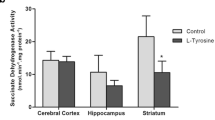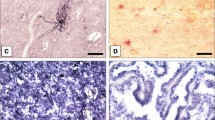Abstract
Guanidino compounds of guanidinoethanesulfonic acid, guanidinoacetic acid, guanidinosuccinic acid, N-acetylarginine, β-guanidinopropionic acid, creatinine, γ-guanidinobutyric acid, arginine, guanidine, methylguanidine, homoarginine and α-guanidinoglutaric acid are present in the mammalian brain. These guanidino compounds except for arginine and guanidine induce seizures and convulsions in rat, rabbit and cat by intracisternal injection.
Hirudonine, audonine, α-keto-δ-guanidinovaleric acid, N,N′-dibenzoylguanidine and phenylethylguanidine are also convulsants. Levels of creatinine, guanidinoethanesulfonic acid, creatinine, guanidinoacetic acid and methylguanidine in animal brain were changed at pre- and during convulsions induced by pentylentetrazol, amygdala kindling, iron-induced epileptogenesis and so on. These convulsions are thought to be due to depressed functions of serotonergic neurons and accumulated free radicals.
Arginine is a substrate of nitric oxide production by nitric oxide synthase. α-Guanidinoglutaric acid is a generator of superoxide, hydroxyl radicals and nitric oxide, and induced C6 glial cell death. On the other hand, aminoguanidine is a free radical scavenger. Energy formation by creatine metabolism may inhibit apoptosis induced by pathogenesis. Free radical generation/reaction and energy generation by guanidino compounds must be important key role in the brain.
Similar content being viewed by others
References
Jinnai D, Mori A, Mukawa J, Ohkusu H, Hosotani M, Mizuno A: Biochemical and physiological studies on guanidine compounds induced convulsion. Choong Jpn J Brain Physiol 106: 3668-3673, 1969
Mori A, Hiramatsu M, Takahashi K, Kohsaka M: Guanidino compounds in rat organs. Comp Biochem Physiol 51B: 143-144, 1975
Nakae I: Synthesis of N,N′-dibenzoylguanidine and its convulsive action. Neurosciences 7: 205-217, 1981
Shirakabe Y: Synthesis of phenylethylguanidine and its effects on neurotransmitters of mouse brain and electroencephalogram of cat. Neurosciences 8: 161-170, 1982
Mori A, Hiramatsu M, Numoto A, Robin Y: Action convulsante des derives diguanidiques, l'hirudonine l'arcaine et l'audonine. CR Soc Biol 175: 755-760, 1981
Marescau B, Hiramatsu M, Mori A: α-keto-γ-guanidinovaleric acid induced electroencephalographic epileptiform discharges in rabbits. Neurochem Pathol 1: 203-209, 1983
Mori A, Watanabe Y, Shindo S, Akagi M, Hiramatsu M: α-Guanidinoglutaric acid and epilepsy. In: A. Lowenthal, A. Mori, B. Marescau (eds). Urea Cycle Diseases. Plenum Press, New York, 1983, pp 465-470
Shiraga H, Hiramatsu M, Mori A: Convulsive activity of α-guanidinoglutaric acid and the possible involvement of 5-hydroxytryptamine in the α-guanidinoglutaric acid induced seizure mechanism. J Neurochem 47: 1832-1836, 1986
Hiramatsu C: Guanidino compounds in mouse brain II. Guanidino compound levels in brain in relation to convulsions. Okayama Igakkai Zasshi 92: 427-433, 1980 (in Japanese)
Hiramatsu M, Edamatsu R, Fujikawa N, Shirasu A, Yamamoto Y, Suzuki S, Mori A: Analyses of guanidino compounds in CSF collected by implanted catheter into cisterna magna; changes in guanidino compounds in CSF of rabbits during convulsion. Brain Res 455: 38-42, 1988
Willmore LJ, Sypert GW, Munson JB: Chronic focal epileptiform discharges induced by injection of iron into rat and cat cortex. Science 200: 1501-1503, 1978
Fukushima M: Guanidino compounds in iron-induced epileptogenic foci of rats. Okayama Igakkai Zasshi 99: 787-806, 1987 (in Japanese)
Hisayasu Y, Morimoto K, Otsuki S: Increase of methylguanidine and guanidinoacetic acid in the brain of amygdala-kindled rats. Epilepsia 32: 761-766, 1986
Hiramatsu M, Ohba S, Edamatsu R, Kadowaki D, Mori A: Effect of guanidino compounds on membrane fluidity of rat synaptosomes. In: P.P. Deyn, B. Marescau, V. Stalon, L.A. Qureshi (eds). Guanidino Compounds in Biology and Medicine. John Libbey & Co. Ltd., 1992, pp 387-393
Hiramatsu M, Niiya-Nishihara H, Mori A: Effect of taurocyamine on taurine and other amino acids in the brain, liver and muscle of mice. Neurosciences 8: 289-294, 1982
Hiramatsu M, Edamatsu R, Kohno M, Mori A: Scavenging of free radicals by Sho-saiko-to-go-keishi-kashakuyaku-to. In: E. Hosoya, Y. Yamamura (eds). Recent Advances in the Pharmacology of KAMPO Medicines. Excepter Medica, 1988, pp 120-127
Hiramatsu M, Edamatsu R, Kohno M, Mori A: The reactivity of guanidino compounds with hydroxyl radicals. In: A. Mori, B.D. Cohen, H. Koide (eds). Guanidines. Plenum Press, New York, 1989, pp 97-105
Mori A, Akagi M, Katayama Y, Watanabe Y: α-Guanidinoglutaric acid in cobalt-induced epileptogenic cerebral cortex of cats. J Neurochem 35: 603-605, 1980
Hiramatsu M, Komatsu M, Kido T: The relationship between reactive oxygen species and the α-guanidinoglutaric acid induced seizure mechanism. In: A. Mori, M. Ishida, J.F. Clark (eds). Guanidino Compounds: 5. Blackwell Science Asia Pty Ltd., 1999, pp 193-198
Hiramatsu M, Komatsu M: The detection of nitric oxide from α-guanidinoglutaric acid by hydroxyl radicals using an electron spin resonance method with spin trap. In: P.P. Deyn, B. Marescau, I.A. Qureshi, A. Mori (eds). Guanidino Compounds. John Libbey & Co. Ltd., 1997, pp 31-36
Seki S, Yuyama N, Hiramatsu M: Effect of guanidino compounds on hen egg development. In: A. Lowenthal, A. Mori, B. Marescau (eds). Urea Cycle Diseases. Plenum Press, New York, 1983, pp 465-470
Komatsu M, Hiramatsu M, Willmore LJ: Zonisamide reduces the increase in 8-hydroxy-2′-deoxyguanosine levels in the brain formed during iron-induced epileptogenesis in rats. Epilepsia 41: 1091-1094, 2000
Holtzman D, Kekelize T: Guanidino compounds in studies of brain ATP metabolism. In: A. Mori, M. Ishida, J.F. Clark (eds). Guanidino Compounds: 5. Blackwell Science Asia Pty Ltd., London, 1999 pp 3-15
Matthew RT, Kaddurah-Daouk R, Beal M: The neuroprotective effect of creatine and its analogs in animal models of neurodegenerative diseases. In: A. Mori, M. Ishida, J.F. Clark (eds). Guanidino Compounds: 5. Blackwell Science Asia Pty Ltd., London, 1999, pp 105-115
Author information
Authors and Affiliations
Rights and permissions
About this article
Cite this article
Hiramatsu, M. A role for guanidino compounds in the brain. Mol Cell Biochem 244, 57–62 (2003). https://doi.org/10.1023/A:1022491419813
Issue Date:
DOI: https://doi.org/10.1023/A:1022491419813




